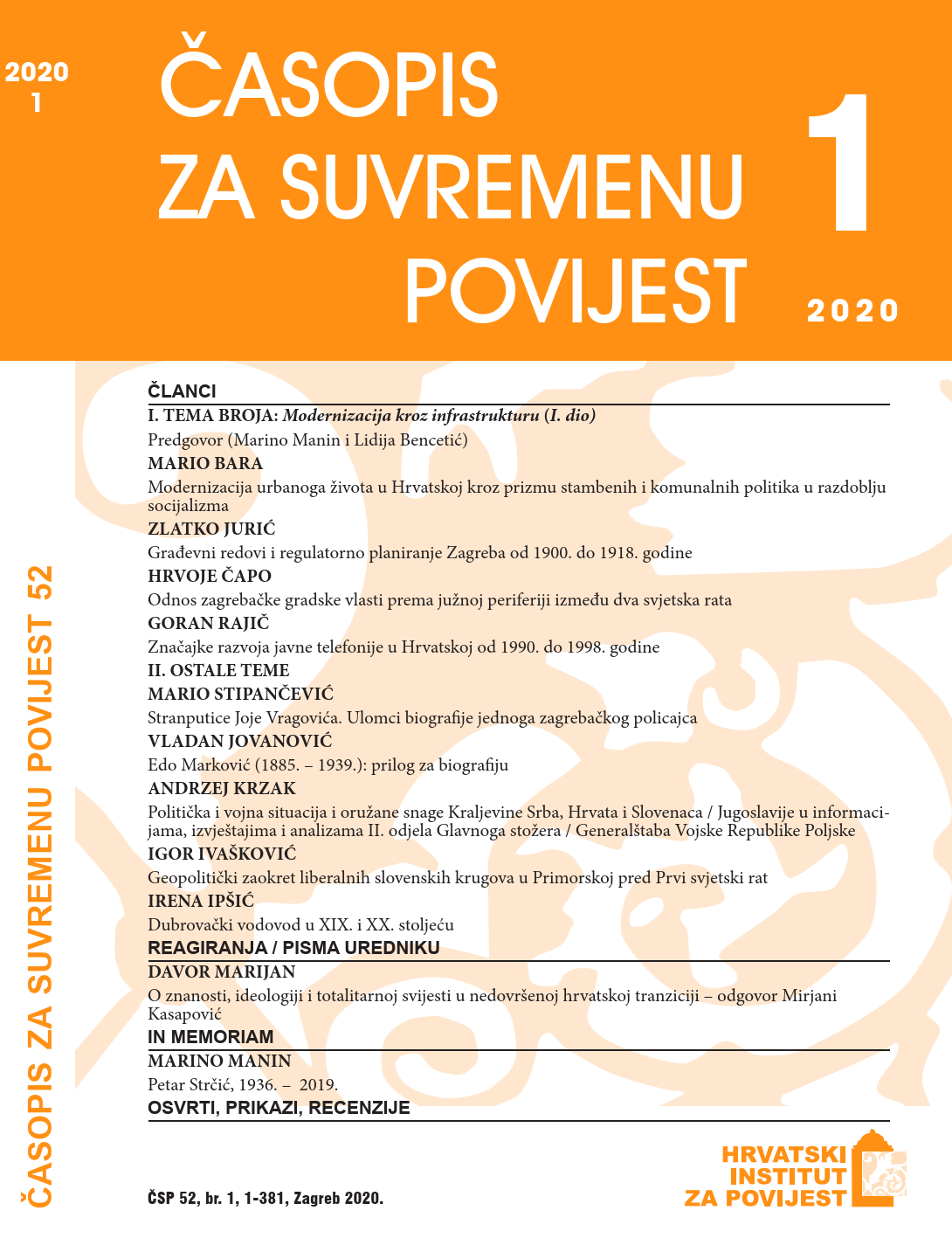Odnos zagrebačke gradske vlasti prema južnoj periferiji između dva svjetska rata
The Relationship of the Zagreb City Authorities towards the Southern Periphery in the Interwar Period
Author(s): Hrvoje ČapoSubject(s): Local History / Microhistory, Rural and urban sociology, Interwar Period (1920 - 1939)
Published by: Hrvatski institut za povijest
Keywords: Zagreb; southern periphery; 1918–1941; regulation of the river Sava; illegal building;
Summary/Abstract: The southern periphery area appeared in the city government’s development plans in the late 19th century, and was envisioned as an industrial and recreative area that would include a port on the river Sava. Its value as a residential area was foreseen only in the Main Regulatory Plan of 1930/31, which was approved in 1940. The lack of a regulatory basis for this area was the consequence of the unregulated flow of the Sava, whose annual flooding remained a threat, and also of the railway to the north, which cut the area off from the Lower Town and city centre. This so-called ‘Railway Question’ burdened the city government for decades after the erection of the Main Railway Station building in 1892, though it was somewhat ameliorated by the construction of an underpass on Miramarska Road in 1913. The separation of the southern periphery from the city due to the railway and the unregulated Sava prevented the development of the city in the north-south direction, so it developed longitudinally. The regulation of the Sava began in 1899, and by 1918 the river was consolidated into a single riverbed, its branches were cut off, and it was set into a characteristic bend with a centreline perpendicular to the medieval city core. However, the threat of flooding continued until the 1930s, when the Trnje embankment was completed, providing at least some protection for the southern border of the southern periphery.An urban population boom, characteristic of cities across the globe after World War I, took place in Zagreb. Most of the growth was due to people moving in from Zagreb’s rural surroundings and northern Croatia. One of the first problems that were detected was the lack of housing, especially that which would be affordable to the newly arrived immigrants. Although many of them found employment in the city or the factories that had by then developed on its periphery, their limited and modest incomes soon drove them out of the city centre and towards the periphery. There they built houses and had space for gardens and domestic animals, mostly on rented lots. The most pronounced characteristic of the population of the southern periphery was illegal construction; between 5,000 and 6,000 such buildings were erected in the interwar period. This phenomenon naturally led the new citizens into conflict with the city government.Even though Marxist historiography accused the ‘bourgeois government’ of deliberately ignoring the population of the periphery, this seems to be an exaggerated interpretation, though these citizens were often treated as ‘little people’. Various city governments, especially in the 1930s, had a pronounced social dimension, especially in regard to basic social benefits, but also in the construction of a limited number of dwellings for the poorer strata of the population. It seems more accurate to say that the city authorities ignored the southern periphery area. The city government lacked the funds to properly deal with the less-than-ideal area that was literally cut off from the city due to the railway and also exposed to flooding, which reinforced the mutual feeling of isolation.In this entire period, the population of the southern periphery was addressed as ‘little people’ and they never reached the level of ‘citizens’, marking this area a sort of ‘non-city’. In this sense, it is no wonder that, after the flood of 1923, only around 75 Zagreb citizens donated (mostly useless) clothing and footwear to victims from the periphery. Their relationship was problematic and full of mutual accusations. However, these ‘non-citizens’ and ‘little people’ actually forced the city government to begin addressing the southern periphery. Positive changes can be detected from the 1930s, during the mandate of Ivo Krbek. Following the mass immigration after World War I and until 1928, the inhabitants of the southern periphery reached a critical mass, i.e. they had sufficient numbers to allow them to remain in this area. The ideal plan of the city government was to buy houses from illegal builders or to offer them land in the regulated parts of the city, and thus free up this space for some future urban development. However, the chronic lack of funds and lots as well as the inadequate utility infrastructure hindered these efforts and widened the gap between ‘city’ and ‘periphery’.
Journal: Časopis za suvremenu povijest
- Issue Year: 52/2020
- Issue No: 1
- Page Range: 53-80
- Page Count: 28
- Language: Croatian

